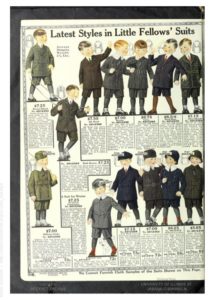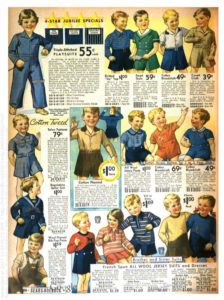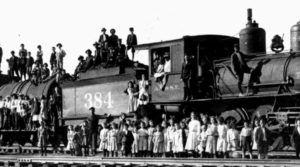This project focuses on the different ways that shirts affected childhoods in america from 1850 to 1950. Throughout history almost every culture has used clothing as a marker of class and gender. People often make assumptions about many aspects of people’s lives based on the clothes they wear and this is no different for children during the late 1800’s and early 1900’s. The clothing that children wore depended on their age, class, gender and race. The clothing of these groups also changed significantly during these years as changes in technology made clothing more affordable and new businesses gave more people the ability to purchase new products. Clothing also affected children’s lives by the way it was made. Most shirts in this time were made from cotton grown in the southern states. These cotton farms were powered by a high amount of child labor because during this time the southern states didn’t have very strict laws regarding child labor. Families in the south  were poorer than families in the north so that provided an extra incentive for families to have their children work from as early an age as possible. Along with the cotton farms, textile manufacturers used child labor to help work the machines. These two industries provided their young workers with very different educational opportunities which let these populations achieving very different levels of economic success. Shirts played a different role in the lives of children from different socioeconomic groups during this time. For some children they were a status symbol of their families wealth, for others they were just hand me downs that were worn every day and for others they were how they contributed to their family’s income.
were poorer than families in the north so that provided an extra incentive for families to have their children work from as early an age as possible. Along with the cotton farms, textile manufacturers used child labor to help work the machines. These two industries provided their young workers with very different educational opportunities which let these populations achieving very different levels of economic success. Shirts played a different role in the lives of children from different socioeconomic groups during this time. For some children they were a status symbol of their families wealth, for others they were just hand me downs that were worn every day and for others they were how they contributed to their family’s income.
The way children were dressed is a great window into their childhoods as a whole. Estelle Worrell said that “how people dress their children and how they feel about them go hand in hand. By studying children’s costume, it is possible to gain insight into the attitudes of a society toward its young.” (Cook, 2011, p.9) One way this can be seen is in how clothing manufacturers and retail stores start to advertise to younger children as early as the 1920’s but more and more after world war two. Cook notes that, “Colours, fixtures, themes and the placement and layout of the retail space itself gradually came to be oriented toward the presumed viewpoint of specifically aged and gendered children until, by the 1940s, such practices became commonplace.” (Cook, 2011, p.14) By looking at the changes it advertisers’ approach from only advertising the mothers to advertising more to the children one can see how society had empowered children as decision makers for some purchases within their households. Lisa Jacobson also discusses how companies really started to increase their advertising to kids in the early to mid twentieth century. Companies started by advertising in children’s magazines like St. Nicholas, American Boy and American Girl. At the beginning of the Great Depression most of these magazines went out of business but advertisers were already turning to the radio as a way to advertise to kids. Unlike the magazine which were mostly read by upper class white children, the radio increasingly was able to reach a wider, more diverse audience. (Jacobson, 2004, p.17)
Another way clothing can show how society changed is the emergence of play clothes. In Moore’s article she states that, “Children’s fashion changed between 1890 and 1920 to facilitate active play.” (Moore, 2006, p.84) During this time period child labor became much more contested and laws were passed against it. This meant childhood consisted of much more playtime instead of work. One clothing item that appeared during this time  was the romper. It is a one piece, loose fitting piece of clothing that was originally used as play clothing for toddlers. (Moore, 2006, p.84) Other way that children’s clothing represented a movement in the nation was the rejection of old world traditions and the “Americanization” of immigrant children. In many different ethnic immigrant communities clothing was a battleground for immigrant parents trying to hold on to old world traditions and their children trying to adopt styles of American pop culture. This was especially the case for teenage daughters of immigrants. Elizabeth Ewen interviewed a girl who was living with her husband and she said, “My two younger sisters would come to my house, telling our parents they were visiting. Then they’d change their clothes, get dressed up and sneak out dancing. They always came back at 9:30, they’d change and I’d walk them home. Our parents never knew”. (Cook, 2011, p.13) This shows an example of how children of immigrants tended to reject their parents culture in favor of fitting in with American pop culture. This kind of adoption of clothing styles is one way that immigrant groups became “Americanized” and were able to assimilate into society. That is one way that clothes represented the ideals of the nation. Another way those ideas were represented was the masculinization of boys clothes from and increasingly younger age throughout the early twentieth century. In Moore’s article she says that boys and girls wore the same generic gowns until age seven in the nineteenth century and it was a significant step in a boy’s life when he got to wear pants. In the twentieth century this changed to the point where boys were wearing “masculine” clothing before they could walk by the 1950’s. This change came from the idea that younger boys weren’t manly enough. During this time the country became a lot more urbanized less kids were growing up with an idealized county childhood. Also men were coming back from world war one and later world war two and their experiences in these wars likely caused them to place a high value on the toughness of the boys in younger generations. The wearing of pants from progressively younger ages was one idea that was used to try to improve the perceived toughness of young boys.
was the romper. It is a one piece, loose fitting piece of clothing that was originally used as play clothing for toddlers. (Moore, 2006, p.84) Other way that children’s clothing represented a movement in the nation was the rejection of old world traditions and the “Americanization” of immigrant children. In many different ethnic immigrant communities clothing was a battleground for immigrant parents trying to hold on to old world traditions and their children trying to adopt styles of American pop culture. This was especially the case for teenage daughters of immigrants. Elizabeth Ewen interviewed a girl who was living with her husband and she said, “My two younger sisters would come to my house, telling our parents they were visiting. Then they’d change their clothes, get dressed up and sneak out dancing. They always came back at 9:30, they’d change and I’d walk them home. Our parents never knew”. (Cook, 2011, p.13) This shows an example of how children of immigrants tended to reject their parents culture in favor of fitting in with American pop culture. This kind of adoption of clothing styles is one way that immigrant groups became “Americanized” and were able to assimilate into society. That is one way that clothes represented the ideals of the nation. Another way those ideas were represented was the masculinization of boys clothes from and increasingly younger age throughout the early twentieth century. In Moore’s article she says that boys and girls wore the same generic gowns until age seven in the nineteenth century and it was a significant step in a boy’s life when he got to wear pants. In the twentieth century this changed to the point where boys were wearing “masculine” clothing before they could walk by the 1950’s. This change came from the idea that younger boys weren’t manly enough. During this time the country became a lot more urbanized less kids were growing up with an idealized county childhood. Also men were coming back from world war one and later world war two and their experiences in these wars likely caused them to place a high value on the toughness of the boys in younger generations. The wearing of pants from progressively younger ages was one idea that was used to try to improve the perceived toughness of young boys.
These changes in clothing affected a large portion of society but they did not affect everyone. Many children in this time period had to live in extreme poverty and didn’t have access to new clothing developments. For most of this time period there was very little if any government assistance so many kids had to live on the streets. In the film ‘Orphan  Trains’ many of the people that were interviewed said that their entire possessions consisted of a change of clothes. The charity would dress them in nice clothes to give them a better chance of being adopted. This shows how little these kids had and how clothing could be used to signal to potential adopters that they were good kids. Blacks also did not have much access to clothes, especially at the beginning of this time period. In the early 1850’s slavery was still very prevalent in the southern states were not given the freedom to choose their own clothing. After slavery was abolished Blacks still face segregation and high rates of poverty so they did not have access to new clothing for their children in the same way that the white middle class did.
Trains’ many of the people that were interviewed said that their entire possessions consisted of a change of clothes. The charity would dress them in nice clothes to give them a better chance of being adopted. This shows how little these kids had and how clothing could be used to signal to potential adopters that they were good kids. Blacks also did not have much access to clothes, especially at the beginning of this time period. In the early 1850’s slavery was still very prevalent in the southern states were not given the freedom to choose their own clothing. After slavery was abolished Blacks still face segregation and high rates of poverty so they did not have access to new clothing for their children in the same way that the white middle class did.
